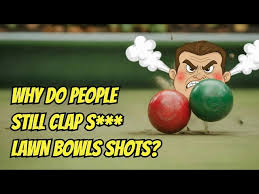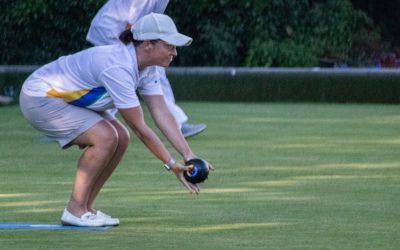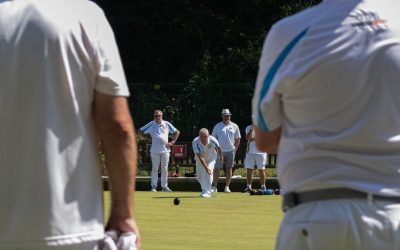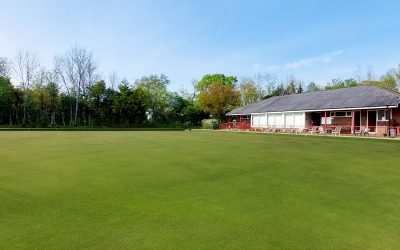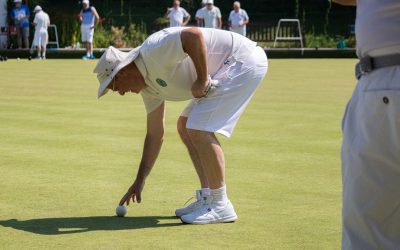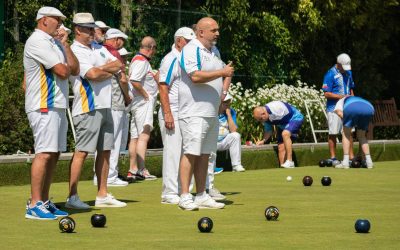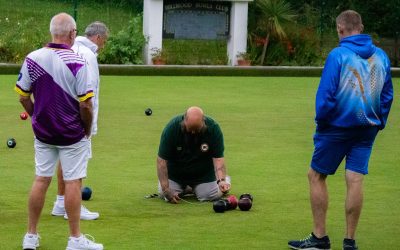The OFFICIAL latest laws:
Law 42.1 the marker must:
42.1.1 make sure that all aspects of play are carried out in line with the Laws of the Sport of Bowls;
Notes:
- your main responsibility is to help the players play the game within the letter and spirit of the laws
- be familiar with the Laws of the Sport of Bowls
- be familiar with the Conditions of Play such as the number of shots or ends and so on
- make sure that you have in your possession the score card, a pen or pencil, a coin, chalk, wedges (if available) and a flexible measure.
Law 42.2 The marker must:
42.2.1 check the mat is placed on the centre line of the rink;
42.2.2 centre the jack;
Notes:
- during the trial ends, ask the player who delivered the jack where they would like it to be centred (for example, where it came to rest or at the 2-metre mark)
- make sure that the mat has been positioned correctly on the centre line of the rink before the player delivers the jack. When checking or directing the position of the mat, adopt a stance on the green as close as possible to the edge of the ditch in a direct line between the two centre-of-rink markers
- if the jack has not been delivered from a properly centred mat, make sure that the player centres the mat before you centre the jack
- centre the jack using your hand;( do not use your foot).
42.2.3 make sure that the jack is at least 23 metres from the mat line after it has been centred;
Notes:
- you must question a doubtful jack length, even if the players do not
- your procedure for checking the jack length should be: centre the jack, check that the position of the mat is in line with the laws, check the distance of the jack from the mat.
42.2.4 place a jack that comes to rest less than 2 metres from the front ditch as described in law 9.2;
Notes:
- when centring a full length jack on a rink which does not have a mark on the green at 2 metres from the edge of the front ditch, use a measuring stick. The front edge of the jack must be placed level with the front edge of the stick (see law 9.2).
42.2.5 stand to one side of the rink, behind the jack and away from the head;
Notes:
- operate from one side of the rink only (the side opposite to the side-ditch which is nearest to the rink)
- do not obscure the rink boundary pegs
- do not obscure the centre-of-rink peg
- keep the same position in relation to the jack at each end (for example, remain close enough to the head to be able to visit it quickly to mark touchers, answer questions or determine which bowl is shot)
- do not leave the boundaries of the rink unless necessary (for example, do not stand on the bank)
- keep still and be quiet
- be alert, decisive and unobtrusive (for example, do not stand with hands in pockets)
- do not engage in conversation with other people such as scoreboard markers, officials, or spectators
- do not initiate any unnecessary conversation with a player
- when a player has initiated a conversation, respond courteously while making sure that it does not distract the player’s opponent or disturb the opponent’s concentration
- do not engage in conversation with either player on any subject which might be construed to be giving the player advice on what to do during the game
42.2.6 answer any specific question about the state of the head which is asked by the player in possession of the rink;
Notes:
- be familiar with the law dealing with possession of the rink (see law 13)
- be polite
- answer only the question asked; do not volunteer additional information
- if you did not understand or hear the question, ask for it to be repeated
- be attentive – avoid the player having either to repeat the question or to wait unduly for a reply
- be familiar with the definition of ‘jack high (jack level)’ (see definition C.27).
42.2.7 when asked, tell or show the player in possession of the rink the position of the jack;
Notes:
- point to the jack and tell the player its position in relation to the nearest bowls, or hold your hand above the jack for a few seconds.
42.2.8 when asked, tell or show the player in possession of the rink which bowl or bowls the marker considers to be shot;
Notes:
- practise assessing distances of bowls from the jack at home.{A bowl is about 12.5 centimetres (5 inches) in diameter; the jack is about 6.5 centimetres (2.5 inches) in diameter; be familiar with the length of your foot; be familiar with the length of your stride}
- if in doubt about which bowl is shot, advise the player that a measure is required.
42.2.9 When authorised by the organiser, signal to players and spectators (using the appropriate number and colour of shot indicators or some other suitable method) which player’s bowl or bowls the marker considers to be shot;
Notes:
- only use shot indicators when authorised by the Controlling Body
- before the start of the game, tell the players that you will be using them
42.2.10 mark all touchers with chalk and remove the chalk marks from non-touchers as soon as they come to rest;
Notes:
- whenever possible, mark touchers as soon as they come to rest (before the start of the game, ask the players to allow you time to do this). Adopting a good position on the rink should enable you to do this without delaying play
- if it has not been possible to mark a toucher as soon as it has come to rest, make sure that it is marked before the next bowl comes to rest
- make sure that players are aware when you are nominating a toucher.
42.2.11 stop any bowl that is from an a neighbouring rink and could move a jack or bowl that is at rest;
42.2.12 if both players agree, remove all dead bowls from the rink of play;
Notes:
- remove a dead bowl as soon as it comes to rest and make sure that the players are aware that you have done so
- do not prevent a jack or bowl from entering the ditch (for example, do not ‘catch’ a bowl which is about to drop into the ditch)
- do not prevent a jack or bowl from crossing the side boundary of the rink – while making sure that such a bowl does not interfere with the head on a neighbouring rink
- stop any bowl from a neighbouring rink which is likely to move the jack or any bowls at rest on the rink on which you are officiating (see laws 37.6.2 and 38.6)
- when an end which has been declared dead is being replayed in the same direction, make sure that all bowls are transferred back to the mat-end in a way which avoids distracting players on neighbouring rinks (see law 20.2).
42.2.13 mark the position of a jack and any touchers which are in the ditch as described in laws 14.4 and 18.2;
Notes:
- be familiar with the laws dealing with marking the position of the jack and any touchers in the ditch (see laws 14.4 and 18.2)
- place indicators on the bank to indicate the position of a jack or bowls in the ditch as soon as they come to rest (remember to remove any such indicators on completion of the end)
- restore to its marked position any jack or bowl in the ditch which has been moved as a result of impact with a dead bowl (e.g. if a non-toucher enters the ditch and disturbs the jack or a live ‘chalked’ bowl).
42.2.14 not move, or cause to be moved, either the jack or any bowls until the players have agreed the number of shots scored; and
Notes:
- before the head is declared, do not touch either the jack or bowls under any circumstances – leave it to the players to determine which bowls should be removed
- use wedges to secure bowls where appropriate (see law 23.6)
- once the head has been declared, do not touch either the jack or bowls – leave it to the players to move them in readiness for the next end.
42.2.15 measure any disputed shot or shots when asked to do so by either player. If the players are not satisfied with the marker’s decision, the marker must ask the umpire (if available) to do the measuring. If the Controlling Body has not appointed an umpire, the marker must choose a competent neutral person to act as the umpire. The umpire’s decision is final.
Notes:
- on completion of a measure, point to the shots; do not ‘turn out’ the shot bowls under any circumstances
- when a marker calls for an umpire to carry out a measure, the marker should tell the umpire how many (if any) shots have already been conceded and to whom
- when a marker who has carried out a measure decides to call for an umpire (for example, because the result of the measure is very close) the marker should not give an opinion on what the outcome will be to either player
- where an umpire has been appointed, the umpire, marker and players can, before the start of the game, agree that should a measure be required and the players do not wish to carry it out themselves, the marker will immediately call for an umpire
- where no umpire has been appointed, the marker and players can, before the start of the game, agree that the players will carry out any measures and, if they cannot agree, the marker will carry out the measure and the marker’s decision will be final
- where no umpire has been appointed, the umpire can be any available, competent person.
- The umpire’s decision is final subject, of course, to the terms of law 43.2.6.
Law 42.3 When each end has been completed, the marker must:
42.3.1 record the score on the score card;
Notes:
- be familiar with the names of the players and make sure that you can identify their bowls (you may find that writing the colour of the players’ stickers against their names on the score card will prove helpful … if marking for players from different teams)
- do not enter on the score card a total score which is higher than that required to determine the winner (for example, in a game where the winner is the first to reach 21 shots, do not record 22 shots if the winner, having started the last end with a total of 20 shots, scores two shots on that end. Only an end score of one shot and a total score of 21 shots must be recorded).
42.3.2 if scoreboards are not being used, tell the players the running totals of the scores; and
Notes:
- confirm to the players both the score at that end, and, if scoreboards are not being used, the total score (for example, three shots to David – the score is now David twelve, Peter ten)
- wait until the players have agreed to the shots before leaving the head
- walk quickly up the rink so as not to delay the start of the next end
- update the score card as soon as practicable, but make sure that you do so before the first bowl of the next end has come to rest
- check the score card against the scoreboards on completion of every end.
42.3.3 remove from the rink the mat used during the previous end, if necessary.
Notes:
- before taking up your position for the next end, lift the mat used during the previous end and place it completely beyond the face of the rear bank, if required.
Law 42.4 When the game has been completed, the marker must make sure that the score card:
42.4.1 contains the names and signatures of the players;
Notes:
- make sure that both players check and then sign the score card. Whenever possible, this should be done before the players leave the vicinity of the rink.
42.4.2 contains the time at which the game was completed; and
Notes:
- the marker must enter on the score card the time at which the game finished.
42.4.3 is dealt with in line with the Conditions of Play.
Notes:
- hand the score card to the competition secretary or umpire for checking (if required)
- when it has been checked by the umpire, hand it to the person listed in the Conditions of Play (for example, the tournament director). Do so as soon as is practicable after the game has been completed (for example, hand it over before you go to the changing rooms).
Additional info regarding distances:

It is hard to find good videos on marking
Some of the terminology in the video below is different to what we say in the UK, the basis of what is being said though is good in regard to what a marker should be doing.
e.g. The ‘hog line’ is what we call the 25 metre markers, and we don’t use ‘arrows’, what we use are the white and red round ditch markers.
What he says about where to stand and how to indicate shots is well explained.
Also, we don’t have sand in our ditches at Millwood but the rules are the same regarding jack or bowls being displaced in ditches …

